Upload Txt File to Root Through Wordpress Without Ftp
Mar 21, 2022
Volition K.
7min Read
The Consummate Guide to WordPress robots.txt

To ensure that your site ranks highly in Search Engine Result Pages (SERPs), you'll need to brand information technology easy for search engine 'bots' to explore its most of import pages. Having a well-structuredrobots.txtfile in place will aid direct those bots to the pages you want them to alphabetize (and avoid the rest).
Download WordPress Cheat Sheet
In this article, we're going to cover:
- What arobots.txtfile is, and why information technology's important
- Where the WordPressrobots.txtfile is located.
- How to create arobots.txtfile.
- What rules to include in your WordPressrobots.txtfile.
- How to test therobots.txtfile, and submit information technology to Google Search Console.
Past the end of our word, you'll have everything you need to configure a perfectrobots.txtfile for your WordPress website. Permit's dive in!
What a WordPressrobots.txtFile Is (And Why Y'all Need I)

When yous create a new website, search engines volition send their minions (or bots) to 'crawl' through it and make a map of all the pages information technology contains. That way, they'll know what pages to brandish as results when someone searches for related keywords. At a basic level, this is unproblematic enough.
The problem is that modernistic websites contain a lot more elements than merely pages. WordPress enables you lot to install plugins, for case, which often come up with their own directories. You don't want these to bear witness up in your search engine results, however, since they're not relevant content.
What therobots.txtfile does is provide a fix of instructions for search engine bots. It tells them: "Hey, yous tin can look hither, but don't go into those rooms over at that place!" This file can be as detailed as you lot want, and information technology's rather like shooting fish in a barrel to create, even if you're not a technical sorcerer.
In practice, search engines volition withal clamber your website fifty-fifty if you don't accept arobots.txtfile set up. However, not creating one is inefficient. Without this file, you're leaving information technology up to the bots to alphabetize all your content, and they're and then thorough that they might end upwards showing parts of your website you don't want other people to have access to.
More than importantly, without arobots.txtfile, y'all'll have a lot of bots itch all over your website. This can negatively bear on its performance. Even if the hit is negligible, folio speed is something that should always exist at the top of your priorities list. After all, there are few things people detest as much equally irksome websites (and that includes united states!).
Where the WordPress robots.txt File Is Located
When you create a WordPress website, it automatically sets upward a virtualrobots.txtfile located in your server's main binder. For instance, if your site is located atyourfakewebsite.com, you should exist able to visit the addressyourfakewebsite.com/robots.txt, and see a file similar this come up:
User-agent: * Disallow: /wp-admin/ Disallow: /wp-includes/
This is an example of a very bonesrobots.txtfile. To put it in human terms, the part right later onUser-amanuensis:declares which bots the rules below apply to. An asterisk means the rules are universal and apply to all bots. In this example, the file tells those bots that they can't go into yourwp-adminandwp-includesdirectories. That makes a certain amount of sense since those two folders contain a lot of sensitive files.
All the same, you may want to add more rules to your own file. Earlier you can practice that, y'all'll demand to sympathise that this is a virtual file. Commonly, the WordPressrobots.txtlocation is within yourrootdirectory, which is oftentimes calledpublic_htmlorworld wide web (or is named after your website):

However, therobots.txtfile WordPress sets up for you by default isn't accessible at all, from any directory. It works, but if you want to make changes to information technology, you'll demand to create your ainfile and upload it to yourrootbinder as a replacement.
We'll cover several means to create a newrobots.txtfor WordPress in a minute. For at present, though, allow'southward talk about how to determine what rules yours should include.
What Rules to Include in Your WordPressrobots.txtFile
In the terminal section, y'all saw an example of a WordPress-generatedrobots.txtfile. It simply included two short rules, but near websites gear up more than than that. Let'due south take a look at 2 dissimilarrobots.txtfiles, and talk about what they each do differently.
Here is our first WordPress robots.txt example:
User-agent: * Permit: / # Disallowed Sub-Directories Disallow: /checkout/ Disallow: /images/ Disallow: /forum/
This is a genericrobots.txtfile for a website with a forum. Search engines will often index each thread within a forum. Depending on what your forum is for, yet, you might desire to disallow it. That way, Google won't index hundreds of threads most users making small talk. You could besides set up rules indicating specific sub-forums to avoid, and permit search engines crawl the rest of them.
You'll likewise discover a line that readsAllow: /at the elevation of the file. That line tells bots that they can crawl through all of your website pages, bated from the exceptions you lot set below. Likewise, you'll notice that nosotros set these rules to be universal (with an asterisk), just as WordPress' virtualrobots.txtfile does.
Now permit's check out another WordPress robots.txt case:
User-agent: * Disallow: /wp-admin/ Disallow: /wp-includes/ User-amanuensis: Bingbot Disallow: /
In this file, we set up the aforementioned rules WordPress does by default. However, we also added a new set of rules that block Bing'due south search bot from crawling through our website. Bingbot, as you lot might imagine, is the name of that bot.
You can get pretty specific about which search engine'due south bots get access to your website, and which ones don't. In practice, of course, Bingbot is pretty benign (fifty-fifty if it's not as cool every bit Googlebot). However, there are some malicious bots out in that location.
The bad news is that they don't always follow the instructions of yourrobots.txtfile (they are rebels, subsequently all). It's worth keeping in listen that, while most bots will follow the instructions you provide in this file, you aren't forcing them to practice and so. You lot're simply asking nicely.
If yous read upward on the subject, you'll discover a lot of suggestions for what to allow and what to block on your WordPress website. All the same, in our experience, fewer rules are often meliorate. Here'south an example of what we recommend your kickoffrobots.txtfile should look similar:
User-Amanuensis: * Allow: /wp-content/uploads/ Disallow: /wp-content/plugins/
Traditionally, WordPress likes to block access to thewp-adminandwp-includesdirectories. Yet, that's no longer considered a best do. Plus, if you add metadata to your images for Search Engine Optimization (SEO) purposes, it doesn't make sense to disallow bots from itch that information. Instead, the to a higher place two rules cover what nearly basic sites will require.
What yous include in yourrobots.txtfile will depend on your specific site and needs, however. Then experience free to do some more research on your own!
How to Create a WordPressrobots.txtFile (3 Methods)
In one case you've decided what volition become in your robots.txt file, all that's left is to create one. You lot can edit robots.txt in WordPress either by using a plugin or manually. In this section, we'll teach yous how to use two popular plugins to get the job done and talk over how to create and upload the file on your own. Permit's go to it!
1. Use Yoast SEO

Yoast SEO hardly needs an introduction. Information technology's the virtually popular SEO plugin for WordPress, and it enables you to optimize your posts and pages to make better use of your keywords. Bated from that, information technology likewise provides y'all with assist when information technology comes to increasing your content's readability, which means more people will be able to enjoy it.
Personally, nosotros're fans of Yoast SEO due to its ease of use. That applies just as much to creating arobots.txtfile. One time y'all install and activate the plugin, navigate to theSEO › Toolstab in your dashboard, and wait for the selection that saysFile editor:
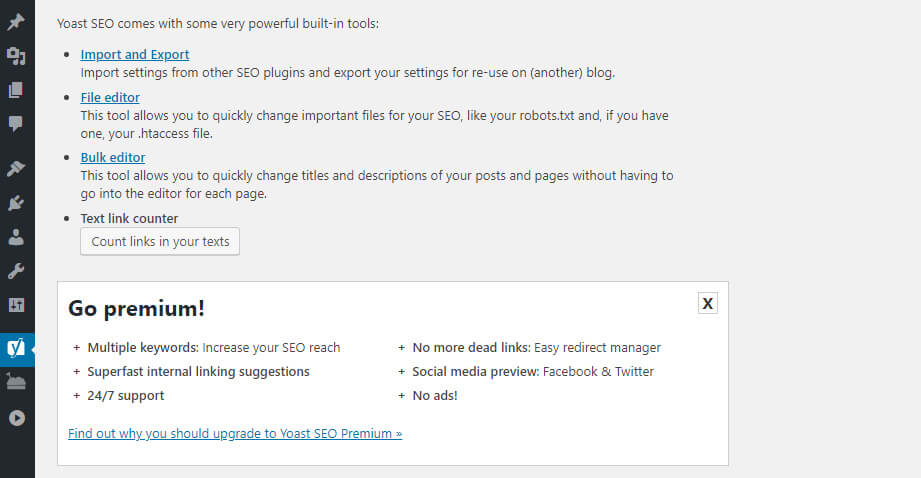
Clicking on that link volition ship you to a new page, where you tin can edit your.htaccessfile without leaving your dashboard. At that place'due south also a handy button that readsCreate robots.txt file, which does exactly what you'd look:
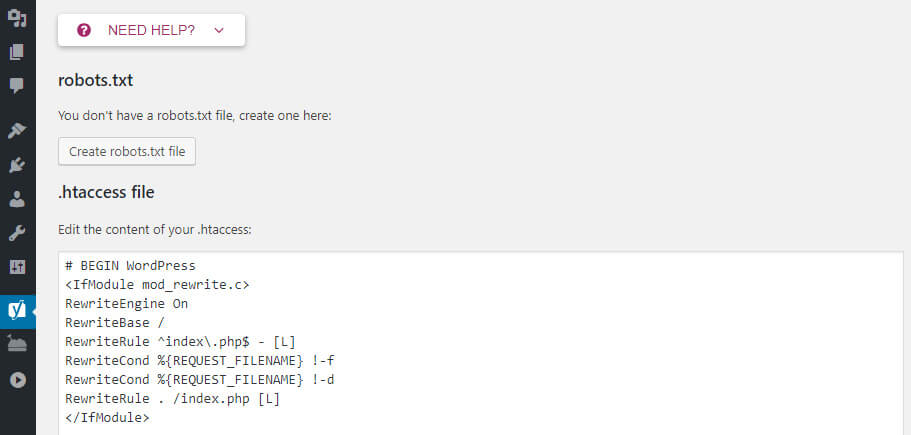
Once you lot click on this button, the tab will display a new editor where you can modify yourrobots.txtfile directly. Go along in mind that Yoast SEO sets its ain default rules, which override your existing virtualrobots.txtfile.
Whenever y'all add or remove rules, remember to click on theSave changes to robots.txtbutton, then they persist:
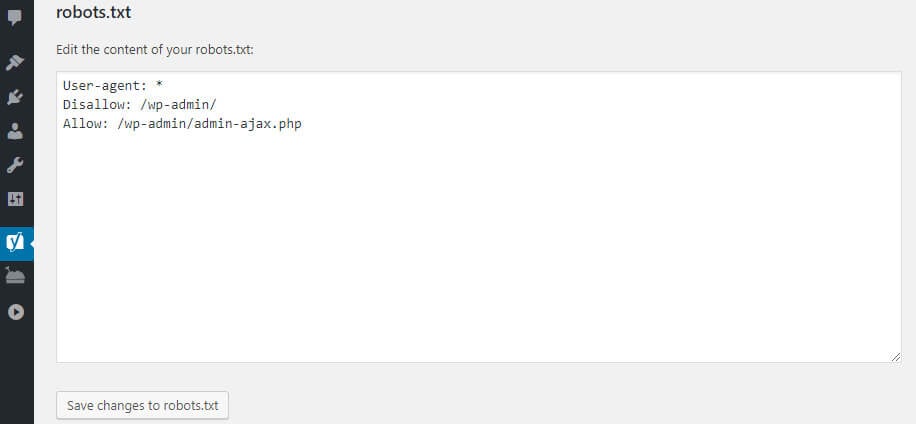
That's easy enough! Now allow's run into how some other popular plugin does the same matter.
2. Through the All in One SEO Pack Plugin

All in Ane SEO Pack is the other large name when it comes to WordPress SEO. It includes nigh of the features Yoast SEO does, only some people adopt it because it'due south a more than lightweight plugin. Every bit far asrobots.txtgoes, creating the file with this plugin is also just as simple.
Once you have the plugin set, navigate to theAll in Ane SEO > Feature Managerpage in your dashboard. Within, you'll observe an option calledRobots.txt, with a conspicuousActivatebutton right below it. Go ahead and click on that:
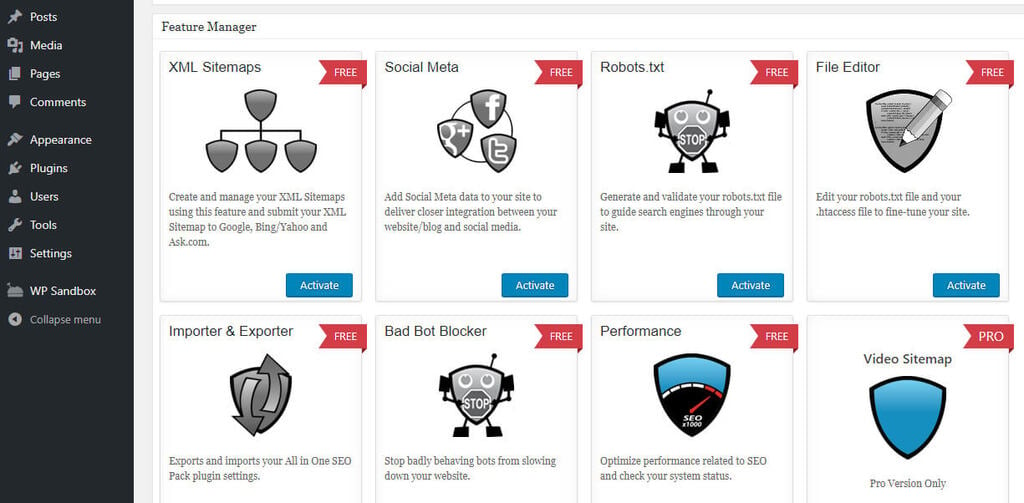
Now, a newRobots.txttab volition testify up under yourAll in Ane SEOmenu. If you click on it, you'll see options to add new rules to your file, save the changes you brand, or delete it altogether:

Practise annotation that you can't make changes to yourrobots.txtfile directly using this plugin. The file itself is grayed out, different with Yoast SEO, which enables you to type in whatever you want:
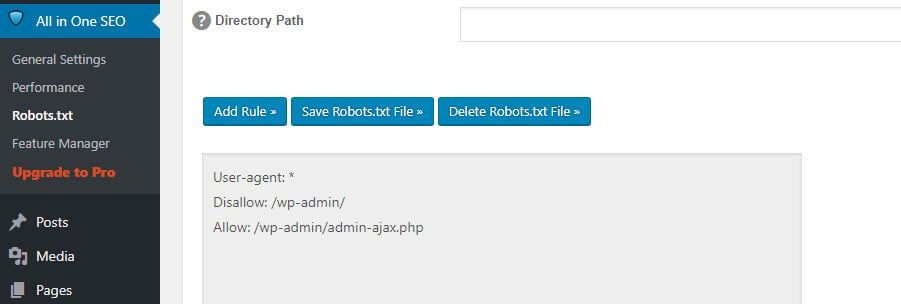
In any case, adding new rules is simple, so don't let that small downside discourage you lot. More importantly, All in One SEO Pack as well includes a feature that can help you block 'bad' bots, which you can access from yourAll in One SEOtab:

That's all you demand to exercise if you choose to use this method. Withal, allow's talk nearly how to create arobots.txtfile manually, if you don't want to set up an extra plugin just to take care of this chore.
3. Create and Upload Your WordPressrobots.txtFile Via FTP
Creating atxtfile couldn't be simpler. All you have to do is open upward your favorite text editor (such as Notepad or TextEdit), and blazon in a few lines. And so you lot can salvage the file, using any proper noun y'all want and thetxtfile blazon. It literally takes seconds to do this, so information technology makes sense that you lot might desire to edit robots.txt in WordPress without using a plugin.
Here'south a quick example of one such file:

For the purposes of this tutorial, we saved this file directly to our computer. Once you take your own file created and saved, you'll demand to connect to your website via FTP. If you're not sure how to do that, we have a guide to doing this using the beginner-friendly FileZilla client.
In one case you're connected to your site, navigate to thepublic_htmlfolder. Then, all you have to practise is upload therobots.txtfile from your computer over to your server. You can do that by either right-clicking on the file using your FTP client's local navigator, or past simply dragging and dropping information technology into identify:

It should only accept a few seconds for the file to upload. As you lot can come across, this method is nearly as simple as using a plugin.
How to Test Your WordPress robots.txt File and Submit It to Google Search Console
Once your WordPress robots.txt file is created and uploaded, you tin can employ Google Search Console to exam it for errors. The Search Console is a collection of tools Google offers to help you monitor how your content appears in its search results. Ane of these tools is arobots.txtchecker, which you tin can utilise past logging into your panel and navigating to therobots.txt Testertab:
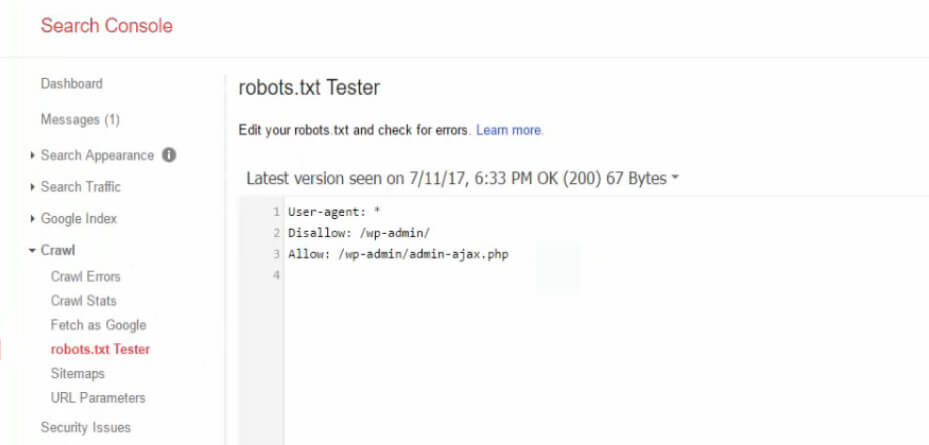
Inside, yous'll observe an editor field where you lot can add your WordPressrobots.txtfile lawmaking, and click on theSubmitbutton correct below. Google Search Console will ask if you lot want to use that new lawmaking, or pull the file from your website. Click on the selection that saysEnquire Google to Updateto submit information technology manually:
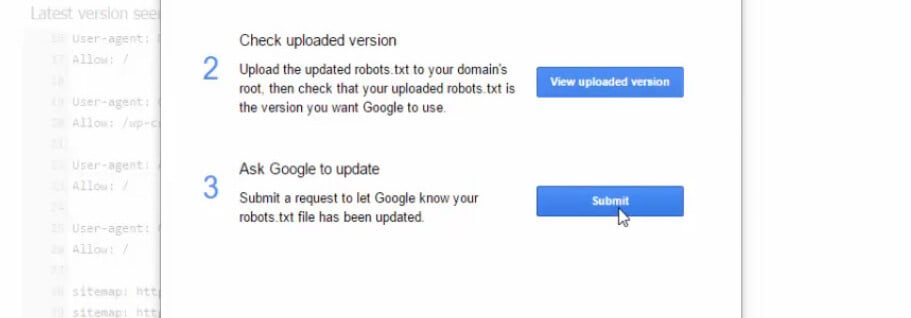
Now, the platform will check your file for errors. If in that location are whatsoever, information technology will signal them out for you. However, you've seen more than one WordPress robots.txt example by at present, and then chances are high that yours is perfect!
Decision
In guild to increment your site's exposure, you'll need to ensure that search engine bots are crawling the most relevant information. As we have seen, a well-configured WordPressrobots.txtfile will enable you to dictate exactly how those bots interact with your site. That way, they'll be able to present searchers with more relevant and useful content.
Do you have any questions nearly how to edit robots.txt in WordPress? Let u.s. know in the comments section below!
Source: https://www.hostinger.com/tutorials/wordpress-robots-txt
0 Response to "Upload Txt File to Root Through Wordpress Without Ftp"
Post a Comment